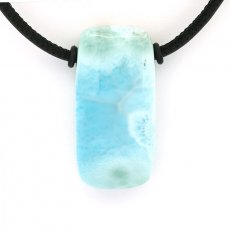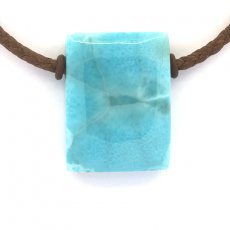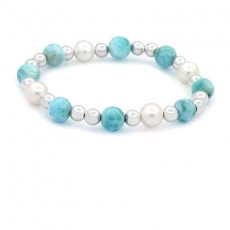Larimar
It's blue colour is very sought after and its shades vary from azure to turquoise.
Contractual photos: The photo on the website is the one of the stone you will really receive.
| 1 to 4 of 4. | 1 |

Larimar: The Caribbean Gemstone
Larimar, also known as the "Atlantis stone" or the "Caribbean gem," is a fascinating and rare gem found exclusively in the Dominican Republic in the Caribbean.
This semi-precious stone has a unique history and aesthetic properties that set it apart.
Geological Formation of Larimar
The formation of Larimar dates back to around 35 million years ago when it emerged from underwater volcanic activity.
Larimar is a variety of pectolite, a mineral belonging to the silicate group.
Its chemical composition is NaCa2Si3O8(OH), and it is the traces of cobalt in its structure that give it its characteristic shades of blue, ranging from pale almost white blue to deep blue, with hints of turquoise.
Larimar gets its name from the nickname "Lari" of the daughter of Dominican artisan Miguel Méndez, Larissa, and the Spanish word "mar," meaning "sea."
This name reflects its deep blue color, evoking the crystalline waters of the Caribbean.
Sources of Larimar in the Dominican Republic
Larimar is an exceptionally rare stone, found only in the Barahona region, located in the southwest of the Dominican Republic.
In the past, before it received its official name, Larimar was often picked up on Bahoruco Beach, a few kilometers from Barahona.
Children would gather these Larimar pebbles to sell to visitors.
Larimar mining began in this mountainous region characterized by steep and slippery terrain in 1976.
Mining Larimar is known to be challenging and dangerous due to the geographical conditions.
History and Cultural Significance of Larimar
The first discovery of Larimar in the Dominican Republic dates back to 1916 when priest Miguel Domingo Fuertes de Loren identified the stone, although its potential was not recognized at the time.
At that time, the Dominican Ministry of Mining denied him permission to mine it, and it fell into obscurity.
The commercialization of Larimar truly began in 1976, thanks to Miguel Méndez, a local artisan, and Norman Rilling, a geologist associated with the Peace Corps.
Larimar was classified as a semi-precious stone in 1979, and since then, its popularity has continued to grow.
The world's only Larimar mine is located in Los Chupaderos, in the Bahoruco National District, 23 kilometers from Santa Cruz de Barahona.
On October 21, 2016, the Dominican government issued a resolution prohibiting the export of amber and Larimar.
Today, Larimar is only allowed to be exported as separately polished pieces.
In the Dominican Republic, the "National Larimar Day" has been celebrated every November 22 since 2018 in honor of the date of the initial discovery of this stone by priest Miguel Domingo Fuertes.
Larimar is considered a symbol of the Dominican Republic, cherished by both Dominicans and visitors.
It is used to create exquisite jewelry and decorative items, with its variety of blue hues evoking the Caribbean waters.
Due to its rarity and beauty, Larimar remains a sought-after semi-precious stone worldwide.
In summary, Larimar is more than just a semi-precious stone; it is a unique piece of the geological and cultural history of the Dominican Republic and an exceptionally beautiful gem that continues to captivate gemstone enthusiasts around the globe.






